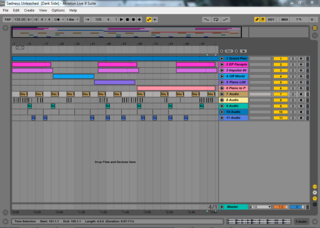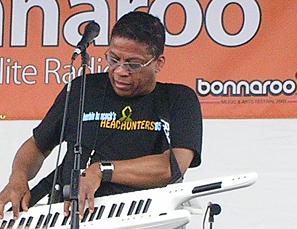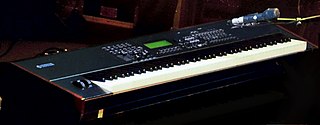
An electronic musical instrument or electrophone is a musical instrument that produces sound using electronic circuitry. Such an instrument sounds by outputting an electrical, electronic or digital audio signal that ultimately is plugged into a power amplifier which drives a loudspeaker, creating the sound heard by the performer and listener.

MIDI is a technical standard that describes a communication protocol, digital interface, and electrical connectors that connect a wide variety of electronic musical instruments, computers, and related audio devices for playing, editing, and recording music.
Zeta Instrument Processor Interface (ZIPI) was a research project initiated by Zeta Instruments and UC Berkeley's CNMAT (Center for New Music and Audio Technologies). Introduced in 1994 in a series of publications in Computer Music Journal from MIT Press, ZIPI was intended as the next-generation transport protocol for digital musical instruments, designed with compliance to the OSI model.
A music sequencer is a device or application software that can record, edit, or play back music, by handling note and performance information in several forms, typically CV/Gate, MIDI, or Open Sound Control, and possibly audio and automation data for digital audio workstations (DAWs) and plug-ins.

The Minimoog is an analog synthesizer first manufactured by Moog Music between 1970 and 1981. Designed as a more affordable, portable version of the modular Moog synthesizer, it was the first synthesizer sold in retail stores. It was first popular with progressive rock and jazz musicians and found wide use in disco, pop, rock and electronic music.

CV/gate is an analog method of controlling synthesizers, drum machines, and similar equipment with external sequencers. The control voltage typically controls pitch and the gate signal controls note on-off.

An electronic keyboard, portable keyboard, or digital keyboard is an electronic musical instrument based on keyboard instruments. Electronic keyboards include synthesizers, digital pianos, stage pianos, electronic organs and digital audio workstations. In technical terms, an electronic keyboard is a rompler-based synthesizer with a low-wattage power amplifier and small loudspeakers.

The Roland JX-3P is a synthesizer produced by Roland Corporation of Japan from 1983–1985. The "3P" in its name refers to "Programmable Preset Polyphonic". It is notable as one of the company's first synthesizers to incorporate a MIDI interface.

Ableton Live, also known as Live or sometimes colloquially as "Ableton", is a digital audio workstation for macOS and Windows developed by the German company Ableton.
Keytar is a keyboard instrument similar to a synthesizer or MIDI controller that is supported by a strap around the neck and shoulders, similar to the way a guitar is held.

The Roland MT-32 Multi-Timbre Sound Module is a MIDI synthesizer module first released in 1987 by Roland Corporation. It was originally marketed to amateur musicians as a budget external synthesizer with an original list price of $695. However, it became more famous along with its compatible modules as an early de facto standard in computer music. Since it was made prior to the release of the General MIDI standard, it uses its own proprietary format for MIDI file playback.

A MIDI controller is any hardware or software that generates and transmits Musical Instrument Digital Interface (MIDI) data to MIDI-enabled devices, typically to trigger sounds and control parameters of an electronic music performance. They most often use a musical keyboard to send data about the pitch of notes to play, although a MIDI controller may trigger lighting and other effects. A wind controller has a sensor that converts breath pressure to volume information and lip pressure to control pitch. Controllers for percussion and stringed instruments exist, as well as specialized and experimental devices. Some MIDI controllers are used in association with specific digital audio workstation software. The original MIDI specification has been extended to include a greater range of control features.

The ARP Odyssey is an analog synthesizer introduced by ARP Instruments in 1972.

The Roland Corporation has manufactured several keytars.

The Continuum Fingerboard or Haken Continuum is a music performance controller and synthesizer developed by Lippold Haken, a professor of Electrical and Computer Engineering at the University of Illinois, and sold by Haken Audio, located in Champaign, Illinois.
EWI is a type of wind controller, an electronic musical instrument invented by Nyle Steiner. The EWI has been used by many artists across many different genres.

A guitar synthesizer is any one of a number of musical instrument systems that allow a guitarist to access synthesizer capabilities.

The Yamaha Music SynthesizerS90 is a synthesizer and a MIDI controller in one unit, released in 2002 to supersede the S80. As such, it is part of the S series together with the S03 and S08. It was superseded by the S90ES in 2005, itself superseded by the S90XS in 2009.

The Split-8 is a polyphonic analogue keyboard synthesizer manufactured by Sequential Circuits. Built in Japan and going by the alternative name Pro-8 in some markets, this was one of the last synthesizers produced by the company and was assigned model number 608. It was released in 1985 at a list price of $1,199. This and some other Sequential Circuits synthesizers were built around the Curtis Electronics CEM 3394 "synth-on-a-chip" integrated circuit, and used a Z80 as their central microprocessor.

The AX60 is a polyphonic analogue keyboard synthesizer manufactured by Akai Professional in the mid-1980s. It was Akai's answer to the popular Roland Juno series synthesizers. The AX60 uses voltage-controlled analogue oscillators and filter circuitry based on the Curtis Electronics CEM 3394 integrated circuit.















